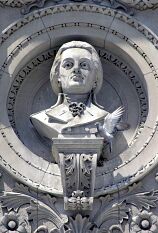Keeping up appearances
Now that restoration is complete, the challenge becomes maintaining the splendor inside and outside the courthouse.
By Kevin Leininger
of The News-Sentinel
 |  |  |  | News-Sentinel photo by Brian Tombaugh
| | Bird's-eye viewA pigeon perches on the shoulder of a courthouse bust of Gen. "Mad" Anthony Wayne to get a better view of the south side of Fort Wayne. A local architect is working on ways to keep the birds off of the Allen County Courthouse. |
|
|
After spending $8.6 million to restore the Allen County Courthouse to its original grandeur, proper maintenance is especially important. Or, as Allen County building engineer Dan Freck put it, "We've put a lot of money into this building. But if we don't take care of it, the money was wasted."
That's why Freck and others plan to protect the community's investment -- inside and out.
The main interior challenge, Freck said, is to keep Charles Holloway's murals in the courthouse rotunda from deteriorating again -- something that can happen if humidity and temperature are not properly controlled.
To prevent fluctuations that could damage the images, Freck said experts are considering several options -- including the installation of sensors that would detect and correct changes in moisture and temperature.
One of the main exterior maintenance problems is no less challenging: pesky pigeons that have been dive-bombing the courthouse and other downtown buildings for years.
However, proposed solutions for keeping them at bay are low-tech.
In fact, the very historic and architectural integrity that make the Allen County Courthouse unique have caused officials to bypass what a local architect believes is one of the most effective deterrents: wire mesh.
"With the wire around the edge of the roof, pigeons find it very difficult to land. It's nasty," said Matt Kelty, whom county officials have asked to find a solution to the pigeon problem. "But we really don't want to use it on the courthouse. It's just not very historic or aesthetically pleasing."
The wire costs about $8 per foot and gives a prickly -- but nonlethal -- surprise to any unsuspecting bird attempting to land.
Birds, Kelty said, like a good view as much as people do. But because the acid in their droppings can damage the courthouse's hard limestone exterior, doing nothing is not an option -- especially since more than 10 gallons of pigeon droppings are removed from the roof twice a year.
Pigeon droppings can also cause health problems if they are allowed to accumulate.
Concerns about possible histoplasmosis contamination from more than 70 pounds of pigeon droppings found above an Owen County Courthouse ceiling in July prompted the temporary closure of the building for cleanup work.
When workers there replaced a speaker system in the building's third-floor courtroom ceiling, they disturbed the accumulated layers of bird droppings. That raised concerns about histoplasmosis, a fungal infection that is often present when bird droppings dry out and degrade.
Kelty, therefore, believes a more preventive approach is needed.
In the City-County Building's garage, electronic devices try to mimic bird sounds to drive away pigeons. Pigeons often present in the garage testify to the devices' ineffectiveness. So Kelty says he may try a third method.
In place of the less-than-sightly wire, Kelty is considering placing a sticky film around the courthouse's roof and on its many ledges.
"It's not as effective, and has to be replaced every three years or so," Kelty said. "And it won't trap the birds, but it should be enough to convince them not to land."
If the sticky film doesn't work, Kelty said the barbed wire remains an option -- whether or not it is historically correct.
"Birds haven't caused dramatic damage yet," he added. "But they will if we don't do something."